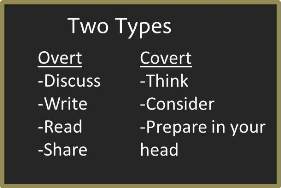 We marketers can learn a lot from teachers. Our goals are very much the same: we want our audience to remember our message. What teachers have known for a long time is that active participation in the learning process increases attention and that in turn increases memory. If marketers can also encourage active participation from our target audience in the messages and stories we are telling about our products, we will reap the benefits of increased brand awareness, leads and sales. Delivering our content via webinars is the perfect opportunity to use active participation to increase our audience’s memory of the concepts presented.
We marketers can learn a lot from teachers. Our goals are very much the same: we want our audience to remember our message. What teachers have known for a long time is that active participation in the learning process increases attention and that in turn increases memory. If marketers can also encourage active participation from our target audience in the messages and stories we are telling about our products, we will reap the benefits of increased brand awareness, leads and sales. Delivering our content via webinars is the perfect opportunity to use active participation to increase our audience’s memory of the concepts presented.
To understand more about how this works, let’s first look at what teachers know:
Active participation leads to attention
In Madeline Hunter’s book Enhancing Teaching, she defines active participation as the consistent engagement of the mind of the learner with the content of the lesson.
There are two types of active participation:
1. Overt Active Participation: physically or audibly performing a task that helps the learner grasp the concept more fully
2. Covert Active Participation: performing a mental activity independently
Attention increases memorability
In the study Interactions between Attention and Memory by Marvin M Chun and Nicholas B Turk-Browne of the Department of Psychology, Yale University the following conclusions were drawn:
“…memory has a limited capacity, and thus attention determines what will be encoded. Division of attention during encoding prevents the formation of conscious memories…”
“…it is uncontroversial that attending to or focusing on a fact or event will enhance the likelihood of later memory…”
“Classic psychologists such as William James stated long ago that ‘we cannot deny that an object once attended to will remain in the memory, while one inattentively allowed to pass will leave no traces behind’”
Therefore, marketers need to do all they can to grab the attention of their audience and ensure that audience is focusing completely on the concept they wish the audience to remember.
What this means for webinar production:
 If active participation leads to attention which leads to memorability, then the production of a webinar needs to be centered on interactivity for maximum impact. We marketers must focus on keeping the attention of the audience that we worked so hard procure, so that our message breaks through digital distractions and our investment yields a return.
If active participation leads to attention which leads to memorability, then the production of a webinar needs to be centered on interactivity for maximum impact. We marketers must focus on keeping the attention of the audience that we worked so hard procure, so that our message breaks through digital distractions and our investment yields a return.
We need to encourage both overt and covert active participation throughout a webinar to engage the audience’s mind with the content we are delivering. Fortunately, webinar technology is exactly designed to foster interactivity and engagement. Here are some ideas for integrating active participation throughout your next webinar to capture and maintain attention:
Overt Active Participation:
– Share: Use a Q&A or chat to ask the audience to share their experience with the topic at hand. An open chat method for this exercise will allow the audience to learn from their peers attending the event as well as from you.
– Brainstorm: Ask the attendees to write in an open chat what they could do with the information you just presented – engaging their minds around applying the concept you just introduced to their own situation. You might consider a pro and con list using two chats if appropriate for the exercise.
–Write: Instruct your attendees to take out a piece of paper and draw their own version of a diagram, chart or something that you have shared which will help them actively learn and make the concept their own. In smaller webinars or using breakout rooms you can use the white boarding functionality to accomplish this within the webinar room.
Covert Active Participation:
– Visualize: Ask for the audience to consider and visualize what they would do or say as you describe a concept or situation.
– Consider: Prompt the attendees to consider or prepare an answer in their head in preparation for an overt exercise where they will be asked to share their thoughts or insights with the group. Continually encouraging the audience to think this way throughout the presentation regardless of whether a more overt exercise will follow will help remind the audience to engage their minds with the topic at hand.
I’m sure you can think of many additional ways to foster active participation in your next webinar for maximum content retention.
Sources and Further Reading:
What Is Active Participation? by Leela J. George
Enhancing Teaching by Madeline Hunter
Interactions between Attention and Memory by Marvin M Chun and Nicholas B Turk-Browne
